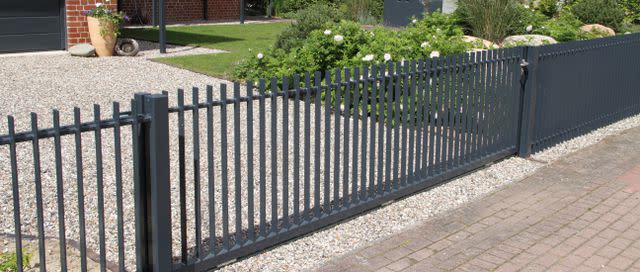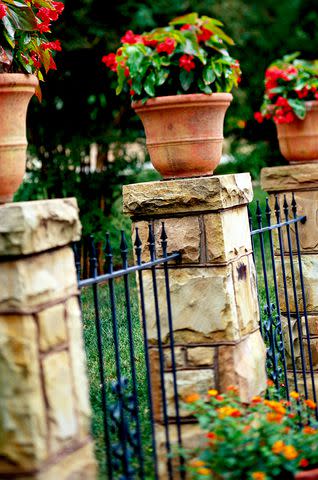Guide to Fence Materials: How to Choose the Best Fence For Your Yard
With all the available choices of materials out there, it can be challenging to determine the right choice for your yard. Here’s what you need to know.

Fences serve many purposes. A well-placed fence keeps intruders out and provides secures a space for you and your family—separate from neighbors and passersby. Fences can also prevent pets and children from wandering off the property. When placed around the pool, it can help prevent accidents and offer peace of mind.
Apart from the practicality, a well-maintained fence enhances curb appeal. But there is a lot to consider before building a fence, like choosing the proper material, placement in your yard, building codes, zoning laws, property lines, your budget, the climate, and pets. Ultimately, the decision to fence in your yard will depend on your specific needs and preferences. Here’s everything you need to know to make the best decision for your home.
Common Fence Materials
Read on to learn more about the different types of fencing materials and how to install them.

Mark Hochleitner/Getty Images
Aluminum
Aluminum fences are a simple solution for separating spaces. Resistant to rust and corrosion, they require no painting or staining. They are easily cleaned with soap and water. Aluminum fences are also lightweight, making them easy to install. Their height and length can be customized to fit any property. They are ideal for areas with moderate weather conditions but not suited for areas with high wind. Be mindful that any vegetation or plants are likely to make their way between the openings of the fence, so lawn care should include cutting back any vines. While chain-link fences can be made of steel wire, many are made of aluminum.

Perry Mastrovito/Getty Images
Steel Chain-Link
Chain-link fences are practical and budget-friendly. They are an excellent solution for enclosing large areas because they are low-maintenance and withstand harsh weather conditions. They don’t block the view, so they are great for pools and playgrounds. On the flip side, they do not offer privacy or a sound barrier. Noisy dogs will bark at passersby. Some clever animals can chew through chain-link or learn to dig under it.

Wood
Wood fences are classic. They offer an attractive, natural look that blends in with any yard or landscape. From a traditional picket fence to a natural bamboo barrier, wood fences can last for decades without warping or rotting. They are easy to install but require regular maintenance, like staining and sealing, to keep them looking their best.
When installing, secure the posts with concrete to prevent sagging. Wood fences are also an effective noise barrier if you have loud pets or neighbors. It might not be the best option in areas with high humidity, heavy rainfall, or wood-eating bugs.

ghornephoto/Getty Images
Vinyl
Vinyl fences are a great, low-maintenance alternative to wood fences. They are resistant to weather, pests, and rot. They also come in a range of colors and styles. Durable enough to last 20 to 30 years, they are a popular choice for homeowners who want to set it and forget it. Vinyl holds up well against extreme weather conditions or frequent rainfall. They are also easy to clean with a hose or power washer.

Wrought Iron
Wrought iron fences are an elegant, timeless home feature. They can bring together outdoor window and patio elements. Otherwise, they are eye-catching even if they stand alone. Wrought iron fences are also customizable, allowing you to choose from different styles and designs. They can be painted or powder coated to match your favorite decor. Painting them every couple of years should keep them aesthetically pleasing.
Wrought iron fences are recommended for yards that could use a high-end and sophisticated look. For anyone who wants to create a custom design with whimsical charm, wrought iron fences can’t be beaten. They may not be suitable in areas with extreme weather conditions or frequent rainfall. Work with a local ironsmith to determine the best options and a realistic timeline to enclose your space.
How to Decide on a Fence Material?
To make an informed decision, you’ll need to consider a variety of factors: cost, installation time, and maintenance requirements. Here’s what you need to know.
Cost: The most affordable fencing is steel chain link, followed by aluminum and vinyl. Wood varieties can also be affordable, especially if the wood is locally available. Wrought iron will put a bigger dent in your pocket. Remember, prices vary based on the size of the fence, complexity of the design, choice of supplier or contractor, and availability of materials.
Installation Time: Think long and hard about how quickly you need this fence built. If you have an immediate pet, neighbor, or intruder problem, you’ll need a solution fast. Chain-link, aluminum, and vinyl have relatively quick manufacturing processes. Wood fences require more time for production, as the materials need to be cut, shaped, and treated. Installation time can also vary depending on the complexity of the design and the layout of the fence. Wrought iron fences are custom-made, and they will take longer to design, manufacture, and install. Professional installation is particularly time-consuming, and any miscalculation requires welding or significant fixes.
Maintenance: Fences are susceptible to damage. Cars, bugs, people, and pets have a way of bending and breaking even the strongest fencing materials. Similar to their installation times, repair times can vary by the extent of the damage and the availability of replacement materials. Repair and replacement of wood fences can be more labor-intensive compared to other materials, as individual boards or sections may need to be addressed. Wood fences require regular maintenance, such as staining or painting, to prolong their lifespan. Wrought iron is highly unlikely to break, but when it does individual sections must be replaced. These will also need to be custom-made to look like the original, which can take time.
For more Better Homes & Gardens news, make sure to sign up for our newsletter!
Read the original article on Better Homes & Gardens.

